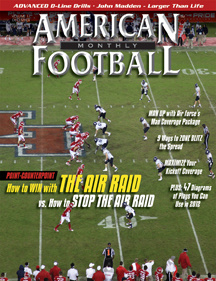AMERICAN FOOTBALL MONTHLY THE #1 RESOURCE FOR FOOTBALL COACHES
|
|
Article Categories
|
Drills Report – Expanded – Advanced Defensive Line Play Techniques and Drillsby: Tim TobinDefensive Line Coach Kutztown University © More from this issueAt Kutztown University, we believe in an aggressive, attacking style of play from our defensive line. Here are seven coaching points and seven drills to help your defensive line improve every day.
Coaching Point #1 – We use this acronym every day.
SACKER
S - Stance (balanced and coiled)
A - Alignment (See foot and shoulder)
C - Concentration (What are you looking at?)
K - Keys (mirror feet)
E - Evaluate (what do you see?)
R - Responsibility (playing the right gap)
Coaching Point #2 – Before the snap
Alignment – We align our eyes on the shoulder of the offensive lineman to the side of our shade. Players need to see the feet of their key. When stunting to a different gap, we tell our players to get into a ‘smart alignment.’ This means getting into....The full article can only be seen by subscribers.
Subscribe today!

|
|
|
NOT A SUBSCRIBER?
Subscribe
now to start receiving our monthly magazine PLUS get INSTANT
unlimited access to over 4000 pages of 100 percent football coaching
information, ONLY available at AmericanFootballMonthly.com!
|
|
|
HOME
|
MAGAZINE
|
SUBSCRIBE
|
ONLINE COLUMNISTS
|
COACHING VIDEOS
|
Copyright 2025, AmericanFootballMonthly.com
All Rights Reserved






